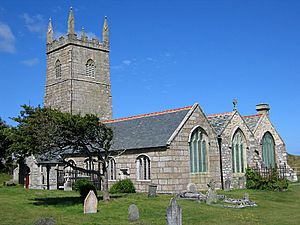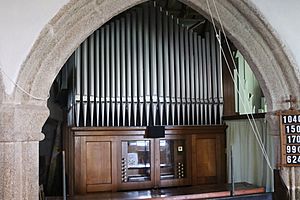St Uny's Church, Lelant facts for kids
Quick facts for kids St Uny Church, Lelant |
|
|---|---|

St Uny Church
|
|
| 50°11′17″N 05°26′06″W / 50.18806°N 5.43500°W | |
| OS grid reference | SW548377 |
| Denomination | Church of England |
| Churchmanship | Broad Church |
| History | |
| Dedication | St Uny |
| Administration | |
| Parish | Lelant, Cornwall |
| Archdeaconry | Cornwall |
| Diocese | Truro |
| Province | Canterbury |
St Uny Church in Lelant, Cornwall, is a special old church that belongs to the Church of England. It is named after Saint Uny, who is also a patron saint for the town of Redruth. This church is considered a very important historical building and is listed as Grade I listed.
Contents
History of St Uny Church
Building the Church
This church is very old, built during the Middle Ages. It is made entirely from strong granite stone. Some parts of the church, like the arches inside, show a style called Norman architecture. This means they were built around the 1100s. The windows, however, were changed later to a style called Perpendicular architecture, which was popular in the late 1300s to early 1500s.
Around the year 1150, the church was given to a religious house called Tywardreath Priory. Later, the priory sold it to Bishop Bronescombe of Exeter. In 1272, Bishop Bronescombe gave the church to Crediton collegiate church. This meant that the local priest, called a vicar, became responsible for the people's spiritual care.
Changes Over Time
In the late 1400s and early 1500s, the vicars of Lelant had disagreements with people from nearby Towednack and St Ives. These towns wanted their own burial grounds. When this was finally allowed in 1542, the vicars moved their homes to St Ives. They stayed there for about 300 years.
One of the earliest mentions of the church was in 1170. Thomas Becket, who was the Archbishop of Canterbury, called it "The Church of Saint Euni." People still celebrate St Uny's feast day on February 1st each year. Like many churches in Cornwall, St Uny Church has a special letter from King Charles I. He sent it to thank the people of Lelant for their help during the English Civil War.
Language and Repairs
In 1572, a court record mentioned an argument that happened inside Lelant church. It showed that people usually spoke the Cornish language in the area. It was unusual to hear English spoken there at that time. This record also helps us know the Cornish names for the language, Kernowek, and for Allhallowtide, which was called Kalan Gwav.
By the early 1700s, the church needed a lot of repairs. Strong winds blew sand into the building, causing damage. In 1727, the community raised money, about £263, to fix it. In 1731, church records show a payment for someone to carry sand out of the church for a whole day!
The church was repaired again in 1873. This time, it cost £1,175. On December 12, 1878, lightning struck the tower's top corner. When people checked the tower, they found that the floor where the bells were kept was rotten. The bells were only held up by their frame! Money that was meant for building Truro Cathedral was used to make the tower safe. The tower was fixed, and the bells were put back in January 1880.
Famous People Connected to the Church
St Uny Church has beautiful memorials for two important people named William Praed. Their family home was nearby at Trevethow. Also buried here are Henry Jenner (1848–1934), who was the first leader of the Gorseth Kernow (a Cornish cultural group), and the artist Peter Lanyon (1918–1964).
Church Organ
A new organ was put into the church in 1913. It was built by John Hele from London, Exeter, and Plymouth. The organ cost £415 at the time. It was first placed in the north part of the church near the altar. Later, it was moved to the back of the north aisle. But in 1989, it was moved back to its original spot. You can find more details about this organ on the National Pipe Organ Register.
Church Bells
The church tower holds six bells. These bells were made by a company called John Taylor & Co in Loughborough. The two oldest bells were made in 1836.


